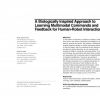Free Online Productivity Tools
i2Speak
i2Symbol
i2OCR
iTex2Img
iWeb2Print
iWeb2Shot
i2Type
iPdf2Split
iPdf2Merge
i2Bopomofo
i2Arabic
i2Style
i2Image
i2PDF
iLatex2Rtf
Sci2ools
109
Voted
CHI
2009
ACM
2009
ACM
A biologically inspired approach to learning multimodal commands and feedback for human-robot interaction
In this paper we describe a method to enable a robot to learn how a user gives commands and feedback to it by speech, prosody and touch. We propose a biologically inspired approach based on human associative learning. In the first stage, which corresponds to the stimulus encoding in natural learning, we use unsupervised training of HMMs to model the incoming stimuli. In the second stage, the associative learning, these models are associated with a meaning using an implementation of classical conditioning. Top-down processing is applied to take into account the context as a bias for the stimulus encoding. In an experimental study we evaluated the learning of user feedback with our learning method using special training tasks, which allow the robot to explore and provoke situated feedback from the user. In this first study, the robot learned to discriminate between positive and negative feedback with an average accuracy of 95.97%. Keywords Human-Robot-Interaction, Speech Perception, Mac...
CHI 2009 | Human Associative Learning | Human Computer Interaction | User Feedback | User Interfaces Copyright |
| Added | 24 Nov 2009 |
| Updated | 24 Nov 2009 |
| Type | Conference |
| Year | 2009 |
| Where | CHI |
| Authors | Anja Austermann, Seiji Yamada |
Comments (0)

